The NSX / 1990
Let’s Build a Sportscar!
The Wako R&D Center in January, 1984 began the basic research on a new drive system, as a means of achieving a shift from Honda’s FF (front-engine/front-wheel drive) vehicle type to another format. In those days, FF was the mainstream of Honda cars, and Honda models used it to ensure superior interior comfort and accommodations.
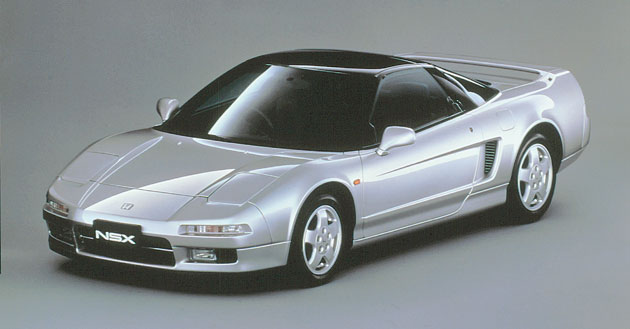
The NSX (September 1990)
However, the development team believed a change in drive format could enhance the flexibility of frame design and packaging. Therefore, the focus of research was to be to an underfloor, midship-engine rear-wheel drive (UMR) format. This could combine higher packaging efficiency along with the sporting characteristics with which rear drive was associated.
The potential in such a change also presented numerous obstacles. It was Honda’s first experience to design a car with the engine in the rear half of the vehicle. In February of the same year, with that in mind, and to expedite their research, the development team constructed a UMR test vehicle from a first-generation City.
During the test drive, the team members were amazed by the unique handling of the car, which differed greatly from the original FF specification. The UMR-version City, in fact, demonstrated superior performance characteristics. Unfortunately, further development had to be set aside because the level of technology then available to Honda placed certain limits on the car’s ability to present any real advantage over the normal FF version.
However, although the project was shelved, the team members simply could not forget the exhilaration they had experienced with the UMR experiment. Moreover, comments had been raised by supporters at the evaluation meetings that the rear-drive City’s dynamic performance should somehow be replicated.
The emphasis in research was therefore modified from drive format to dynamic performance - that which was typically achieved with a vehicle having a lower center of gravity, meaning a sportscar.
"It’s the dream of every development engineer to create a sportscar," said Shigeru Uehara, who was engaged in the development project as LPL. "The people who proposed changing the research direction at the evaluation meetings must also have had that dream."
In 1983, another step was taken, in the form of a prototype car fashioned from a CR-X as a means of testing dynamic performance from various perspectives. This was also the year Honda made its much-heralded return to the F-1 Series. Thus, of course, spirits were high at the R&D Center, in anticipation of the possibility that Honda might indeed build sportscars. Coincidentally, this had often been a subject of discussion at board meetings.
"I think the company wanted a car that could bridge its mass production FF models and F-1 cars," Uehara recalled. "They needed a car that would become the new face of Honda. Plus, we’d been contacted several times by those who were planning the Acura Division at American Honda concerning similar requests."
Honda’s development engineers finally found an outlet for the passions when in the fall of 1985 the creation of a new sportscar began in earnest.

A sketch of the NSX’s exterior, with its sleek profile based on an F16 fighter jet.
A Sportscar in the Image of Honda
"What particular qualities would a sportscar have in representing the Honda name?" This was the ultimate question facing the development team, and they repeatedly engaged in long discussions in the hope of finding an answer. Eventually, once their direction had been identified through the use of a conceptual diagram, they began to define key words in the development of their new car, code-named the NSX.
The diagram was a means of representing power-to-weight ratio (running performance) along the Y-axis and wheelbase-to-weight ratio (turning and stopping performance) along the X-axis in clear, accessible terms. Moreover, the plotting of data from rival models directly over the diagram resulted in a zone of latitude that stretched out like the Milky Way. Because of this shape, the diagram was also called the "Milky Way diagram." Countless discussions centered around it, until at last the development team reached its conclusion:
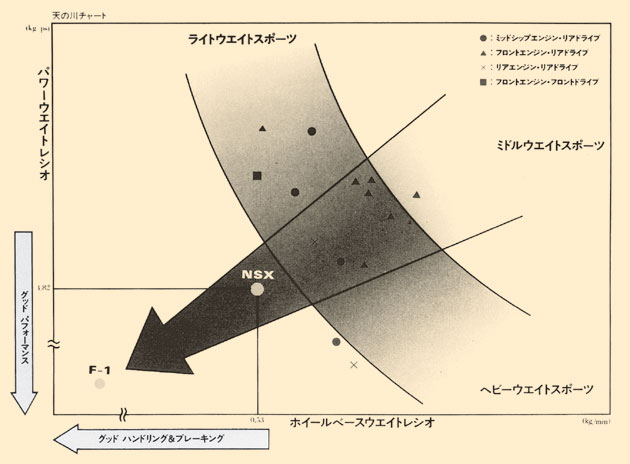
Data from rival models was plotted on the "Milky Way" diagram, with the Y-axis representing power-to-weight ratio (running performance = vehicle weight/engine output) and the X-axis representing wheelbase-to-weight ratio (turning and stopping performance = vehicle weight/wheelbase). The NSX aimed to position itself outside the conventional sportscar realm, at a point as close as possible to F-1 machine.
"What we need is a midrange, midship car that provides superior performance yet requires equally superior driving skills in order to be controlled. We can then maximize the dynamic performance of this car to a degree that’s as close as possible to an F-1 machine."
It was clear, however, that too much dynamic performance could result in compromised cabin space, making the car difficult to control. That simply was not acceptable to Honda, whose prime objective in manufacturing cars and motorcycles was to ensure the comfort of drivers and passengers alike. To Honda, higher dynamic performance had meaning only with the assurance of human compatibility, in which the driver could operate the machine as desired and the vehicle exhibited excellent adaptability to various road conditions.
"To create a sportscar for a new era, we should balance human feelings and vehicle performance at higher levels. Accordingly, that car will represent Honda value; a benefit no one else can offer." This was the consensus of the development staff, and it was to be the concept for their new vehicle.
Designing an All-Aluminum, Monocoque Body
Prototype I was completed in mid-1986, representing the team’s first construction using the Milky Way diagram. At this stage, they were considering both sheet steel and aluminum as potential body materials. Of the two, steel sheet was less favored, since it would make the target running performance of a midrange, F-1 class car more difficult to achieve. Moreover, to counter the added weight a larger, heavier engine would have to be used, thus pushing the car right out of the midrange category. Sheet steel would also be a liability in terms of the car’s purpose, which was to break from the conventional image of a sportscar as a compromise in comfort and safety for the sake of superior slalom statistics. Of course, the team was planning to furnish the car with cutting-edge accessories and devices such as power windows, full-automatic air conditioning, traction control and antilock brakes systems (ABS). To accomplish this, however, the weight of the vehicle would have to be minimized. Thus, it was decided that the NSX would have the world’s first all-aluminum, monocoque body.
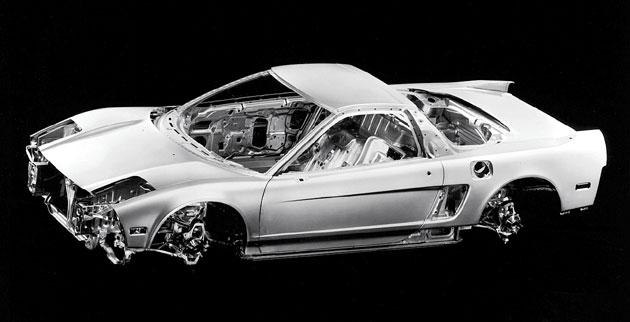
The world’s first mass-production car to offer an all-aluminum, monocoque body.
No other automaker had yet to build a car primarily of aluminum, however, even though the material was pollution-free and in abundant supply. It is said that among the mineral resources the amount of estimated aluminum reserves is three times that of iron. Moreover, aluminum has one-third the specific gravity of iron, is resistant to corrosion, and is much easier to recycle. Despite such powerful advantages, the material has several drawbacks, particularly a high cost and proportionately higher technical requirements in molding and welding. But the development team’s greatest hurdle was the need to build a dedicated plant simply to produce the car’s aluminum body.
The project required that the development team make frequent trips between the R&D centers at Tochigi and Wako. During one such trip, aboard the Shinkansen, they realized that the bullet train was itself made of aluminum.
Aluminum has proved very adaptable to the Shinkansen, in fact. So, the team members saw no reason why it couldn’t be used for the body of a sportscar. And though there might be problems along the way, they made a promise then that they wouldn’t shy away from the challenge of creating a car for the new era.
Kobe Steel and other material suppliers appeared somewhat perplexed at the development team’s request that they collaborate in the creation of an all-aluminum car body. Because aluminum is prone to buckling during stamping work and is difficult to weld, its use in mass-production cars was limited to a relatively small assortment of parts. The suppliers were confused by the team’s decision to make the entire body out of aluminum, and doubted the seriousness of Honda’s intentions. However, the staff offered their earnest explanation to the skeptics, saying they needed an aluminum body to build their new sportscar. It was the kind of honest enthusiasm that eventually led the suppliers to wonder, "why not?"
Various types of aluminum were considered, but the suppliers selected the 5000 and 6000 series. The former was already being used in the automotive industry, while the latter had relatively high strength despite its lower formability. Still, various enhancements would have to be performed. The supply company personnel in charge of development spent many days anguishing over the situation, working feverishly to meet a series of conditions stipulated by Honda in order to ensure productivity in stamping, forming, welding, coating and other processes. In fact, the hours were so long and arduous that toward the end of development they would often spend the night right in their factory.
Problems inevitably arose, and with them came headaches and delays. In particular, processing of the side sill was proving difficult, since aluminum, unlike iron, wasn’t suitable for deeply drawn press work. Therefore, a new forming process was devised whereby the aluminum was heated to 600 degrees, poured into dies, and extruded from the dies while it was being drawn. But this system created a super-strong, highly rigid honeycomb frame, and this technique ultimately became the assurance that their all-aluminum body would satisfy the rigors of high performance on the open road.
A selection of five aluminum alloys was eventually incorporated into the vehicle. This thorough attention to detail—along with numerous other efforts—soon led to a body-weight reduction of 140 kg and nearly 200 kg for the entire car, as compared to a steel-bodied equivalent. It was quite an achievement in the eyes of the material suppliers, too, who were amazed to see just how much of a car could be made with aluminum.
Concurrent with the material development of mid-1986, the development team collaborated with the Suzuka factory in building an aluminum-bodied prototype CR-X. Performance tests were conducted with the prototype, then the results and problems they identified were examined to determine whether it would be practical to build a car with an aluminum body. Next, the team studied the basic frame structure of an aluminum body for a midship sportscar using Prototype I. Several test drives and crash tests were carried out using the prototype, in order to obtain thorough verifications covering everything from rigidity to repair techniques. The results were reflected in Prototype II, which was much closer to a final product. With Prototype II, interior accessories, equipment, passenger comfort and environmental adaptability were considered as part of the car’s overall performance picture.
Subjecting to Severe Tests at Nurburgring
The team spent an entire month at the Suzuka Circuit in the early stages of D-development, where they conducted numerous evaluations using their test car. Then in February 1989, the team had an opportunity to ask famed F-1 driver, the late Ayrton Senna - who had come to Japan in order to test a McLaren F-1 machine - to drive their car.
"I’m not sure I can really give you appropriate advice on a mass-production car, but I feel it’s a little fragile," said Senna, referring to the car’s apparent lack of rigidity. And even though the car was designed for a level of rigidity equaling that of a Porsche or Ferrari, Senna was able to sense slight differences that would have been well beyond range of the typical driver. But based on that comment, the team raised its objectives for rigidity in April, turning again to the test car in order to ensure their target was met.
The chosen test site was to be West Germany’s famed Nurburgring high-speed race course. It was a memorable location for Honda, the site of the company’s F-1 debut. The circuit had an overall length of 20.8 km, over 200 blind corners, and a 300-meter change in elevation. It was an extremely difficult circuit for cars and drivers alike, for whom extreme skills were needed to maneuver through steep ascending and descending sections of track lined with dense plantings of trees. So, it was believed that the course would reveal problems they couldn’t see in Japan. To them there was no better environment in which to test what they hoped would become the world’s finest sportscar.
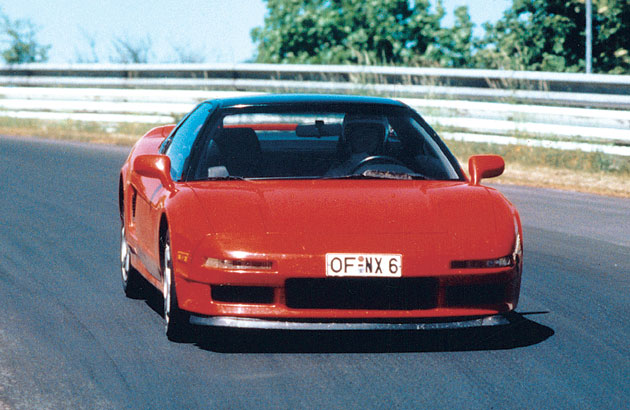
An NS-X running on the Nurburgring course in West Germany. The next-generation sportscar was a product of extreme testing on this course.
Thanks to the assistance of Honda R&D Europe (HRE), the team was able to secure an office and garage in Müllenbach, a town located just two kilometers from the circuit. With their new workshop set up, it was to be the first time a Japanese automaker would conduct long-term testing at an overseas location.
The course offered an immediate venue for the series of tests the team had devised in order to increase their car’s rigidity. They knew that on an extremely difficult course such as Nurburgring even a slight delay in the vehicle’s response to input would obliterate the marriage of interaction between car and driver, and thus rob the latter of the ability to accelerate appropriately. And what they learned was that the body’s poor rigidity had everything to do with the failure of that relationship.
It was an iron-clad rule for any overseas test that in the event of an issue that couldn’t be fully conveyed to the staff in Japan, the team on-site must tackle the issue independently. So, in West Germany the design engineers in charge of the vehicle’s various components took turns sitting in the front passenger seat, evaluating the car’s performance along with the test driver. If any problem was found, a solution would be devised on the spot. It was a distinct departure from the norm, but the team knew it was the only way to build the world’s best car.
The test data taken on site was immediately sent back to the R&D Center in Japan, where the numbers were fed into a computer for analysis. It was in this stage that the optimal shape was determined in order to maximize rigidity and minimize weight.
Accordingly, the car’s rigidity was increased by 50 percent as compared to the figure in place immediately before the West German tests. And so, after eight long months of effort, they had at last achieved the levels of dynamic performance and comfort demanded for a world-class sportscar. The team had arrived at the consummate integration between man and machine.
The 81st Chicago Auto Show held in February 1989 saw throngs of media and consumers surrounding a bright-red sportscar - Honda’s new NS-X (Note: the NS-X was actually introduced as an "Acura" brand car, the upscale sales channel in the U.S.). The development code name, NS-X represented "new," "sportscar" and "unknown world," X being the mathematical symbol for an unknown value. It was the prototype for a new offering that Honda believed would captivate driving enthusiasts around the world.
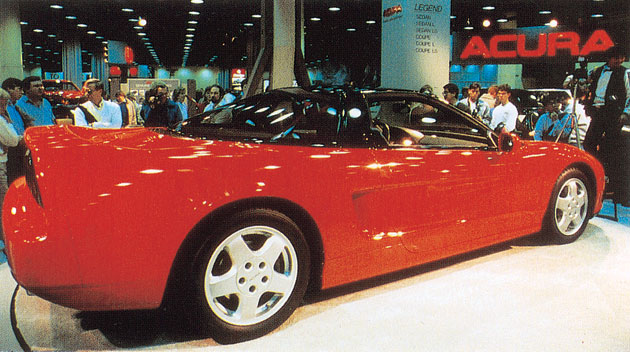
The bright-red NS-X drew crowds of enthusiastic viewers at the Chicago Auto Show in February 1989
The Next-Generation Sportscar
It was to be an exciting time in Honda’s history. In June 1989, the company launched a series of test drives in Japan, eventually moving on to the U.S. and countries throughout Europe.
The American test drives were held at California’s Laguna Seca circuit and on general roads. Laguna Seca was an appropriate choice, since its reputation for extreme difficulty would test the car’s body and suspension performance. Then, having succeeded in that leg of the journey, the team headed for West Germany, where test drives were held near Nurburgring, the circuit that had played a key role in the car’s development.
And at each drive people praised the NSX’s stability, as well as its extremely comfortable accommodations. American journalists, in particular, issued impressive comments such as, "This car will change the standard for modern sportscars," and "All the cars we currently have are now history." These were powerful words indeed, conveying their respect for the new car and its highly advanced technologies. The members of the development team simply couldn’t have been happier.
"A car is a machine that functions through a direct link with the driver and passenger," Uehara said. "The quality of that car is determined by whether or not the car can kindle excitement in the person who drives it."
The birth of the NS-X opened doors to a new era in sportscars. It changed the perceptions of automakers around the world, who learned they could achieve both performance and comfort in a single vehicle.
A Dedicated Plant: The Dream Takes Shape
The construction of Honda’s Saitama Factory’s Tochigi Plant (currently the Tochigi Factory’s Takanezawa Plant) was completed in May 1990 as a facility dedicated to the production of the new, aluminum-bodied sportscar.
All the facilities and equipment employed by the factory were specifically designed for the NS-X, and among them the aluminum spot-welding machine was particularly noteworthy. Aluminum is a highly conductive, heat-sensitive material, and in sheet form it is thicker than steel. For these reasons a greater amount of current is needed for welding. Therefore, a conventional machine wouldn’t be sufficient for that operation. Since no company at the time manufactured a spot-welding machine that could accommodate an aluminum component the size of a car body, a separate project was run at Honda Engineering to develop an original machine, and this was perfected along with the body’s development.
Honda even took a new approach to the assignment of personnel to the plant. It advertised available positions throughout the company, including every departments of each branch and factory, in order to find expert engineers who wished to take part in building the NS-X. Since the production volume was low - just 25 units a day - the operators would need to direct their skills toward "handcrafted" levels of detail. As opposed to mass-production systems where properly calibrated machinery churn out several lots of products in short order, on the NS-X line the operators would make full use of their own senses as a means of calibration. Moreover, the aluminum materials would require manual finishing throughout, meaning that all production personnel would need skills that were proportionate with the added responsibilities.
The new plant was actually designed to yield maximum results from the available human resources. Accordingly, the personnel would have priority over their machines, not vice versa. There was, for example, not a single conveyor belt in evidence. However, a 360-degree rotary welding table was provided in order that the operator could work comfortably without having to crawl beneath the vehicle under construction. Various other systems adopted at the facility were all unique. The plant, in fact, remains a world apart from that of the conventional, mass-production facility.
Tochigi Plant held its open-house ceremony in August 1990. Speaking to an audience assembled there, new Honda Motor President Nobuhiko Kawamoto said, "The NS-X is a next generation car incorporating many unique, proprietary technologies. Therefore, it represents the attainment of another dream for the Honda organization. And Tochigi Plant is where we will further that dream."
A Japanese press conference regarding the new sportscar was held in September 1990, one day before the start of sales at Verno dealerships throughout the country. The code name NS-X, already well-known due to the successful promotion of the prototype vehicle, had been adopted as the official model designation, NSX. But orders had already been pouring in prior to the launch, and the car was soon such a hit that buyers would have to wait as long as three years to get their very own dream machines.
NSX: A Constant Evolution
Honda Motor’s NSX engineering team organized an event for NSX owners in June 1991. The event was intended to give the owners a chance to understand the true capabilities of their car, and to help them enjoy it safely. Yet, those who had created the NSX wanted to continue refining it. As evidence of that commitment, this event continues today at various venues, including the Suzuka Circuit and Twin Ring Motegi.
The two-day curriculum included lectures by the development staff and guest instructors regarding the car’s basic concept and the most effective means to control it on the road. Participants are even given an opportunity to drive their cars on the track. During the program, the users were given opportunities to speak with the development staff and other users, and to share their opinions. The event proved beneficial to the car creators, since they could see things from the customer’s perspective rather than as trained engineers. The requests and other comments obtained through these programs were reflected in the Type R version of the NSX, released in 1992.
And today the NSX carries forward the initial concept in its original development, as the standard by which all other high-performance sportscars are judged.